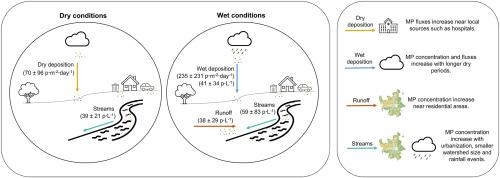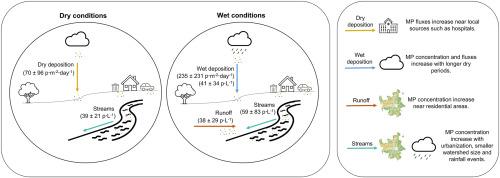Assessment of microplastic transport and distribution in the urban environment of Coimbra municipality
IF 7.3
2区 环境科学与生态学
Q1 ENVIRONMENTAL SCIENCES
引用次数: 0
Abstract
Microplastics (MPs) largely originate from terrestrial environments, especially urban areas, where controlling their spread is difficult. This is concerning due to MPs' impacts on ecosystems and human health. To develop mitigation strategies, understanding how MPs move and spread is essential. This study examined MP transport and distribution in Coimbra municipality, Portugal, at a small watershed scale. Samples were collected from dry and wet atmospheric deposition, runoff, and streams, both before and during rainfall events, across five watersheds with varying urbanization and sizes. MPs were extracted by density separation, counted under a stereo microscope, and identified using μ-FTIR. Results showed higher MP fluxes in wet deposition (235 ± 231 p•m−2•day−1) than dry deposition (70 ± 96 p•m−2•day−1). Stream concentrations nearly doubled during rainfall (59 ± 83 p•L−1) compared to before rainfall (39 ± 21 p•L−1). Wet deposition (41 ± 34 p•L−1) generally had slightly higher MP levels than runoff (38 ± 29 p•L−1) or streams before rainfall, though differences were not statistically significant. Correlations indicated that stream MP levels tended to increase in more urbanized, smaller watersheds, while longer dry periods before rainfall were associated with increased MP levels in wet deposition. Land use influenced MP runoff, with higher concentrations from residential areas, and dry deposition was elevated near a hospital. The most common MPs found were polyethylene, polypropylene, and rubber (5–250 μm). Findings highlight MPs’ widespread transport through the environment and emphasize the need for monitoring pathways. Urban littering and tire wear should receive particular attention. Overall, urgent measures are needed to control plastic production, usage, and environmental dispersion of MPs.


科英布拉市城市环境中微塑料运输和分布的评估
微塑料(MPs)主要来自陆地环境,特别是城市地区,在那里很难控制其传播。由于下院议员对生态系统和人类健康的影响,这一点令人担忧。为了制定缓解战略,了解MPs如何移动和传播至关重要。本研究在葡萄牙科英布拉市的小流域范围内检查了MP的运输和分布。在降雨事件发生之前和期间,从五个不同城市化和规模的流域的干湿大气沉积、径流和溪流中收集样本。密度分离提取MPs,立体显微镜下计数,μ-FTIR鉴定。结果表明,湿沉积的MP通量(235±231 p•m-2•day-1)高于干沉积(70±96 p•m-2•day-1)。与降雨前(39±21 p•L-1)相比,降雨期间溪流浓度几乎翻了一番(59±83 p•L-1)。湿沉积(41±34 p•L-1)的MP水平通常略高于降雨前径流(38±29 p•L-1)或溪流,但差异不具有统计学意义。相关性表明,在城市化程度越高、流域面积越小的情况下,河流MP水平趋于增加,而降雨前较长的干旱期与湿沉积中MP水平的增加有关。土地利用影响了多氯磷径流,居民区的浓度较高,医院附近的干沉积升高。最常见的MPs是聚乙烯、聚丙烯和橡胶(5-250 μm)。研究结果强调了MPs在环境中的广泛运输,并强调了监测路径的必要性。城市垃圾和轮胎磨损应得到特别注意。总之,迫切需要采取措施控制塑料的生产、使用和MPs的环境扩散。
本文章由计算机程序翻译,如有差异,请以英文原文为准。
求助全文
约1分钟内获得全文
求助全文
来源期刊

Environmental Pollution
环境科学-环境科学
CiteScore
16.00
自引率
6.70%
发文量
2082
审稿时长
2.9 months
期刊介绍:
Environmental Pollution is an international peer-reviewed journal that publishes high-quality research papers and review articles covering all aspects of environmental pollution and its impacts on ecosystems and human health.
Subject areas include, but are not limited to:
• Sources and occurrences of pollutants that are clearly defined and measured in environmental compartments, food and food-related items, and human bodies;
• Interlinks between contaminant exposure and biological, ecological, and human health effects, including those of climate change;
• Contaminants of emerging concerns (including but not limited to antibiotic resistant microorganisms or genes, microplastics/nanoplastics, electronic wastes, light, and noise) and/or their biological, ecological, or human health effects;
• Laboratory and field studies on the remediation/mitigation of environmental pollution via new techniques and with clear links to biological, ecological, or human health effects;
• Modeling of pollution processes, patterns, or trends that is of clear environmental and/or human health interest;
• New techniques that measure and examine environmental occurrences, transport, behavior, and effects of pollutants within the environment or the laboratory, provided that they can be clearly used to address problems within regional or global environmental compartments.
 求助内容:
求助内容: 应助结果提醒方式:
应助结果提醒方式:


